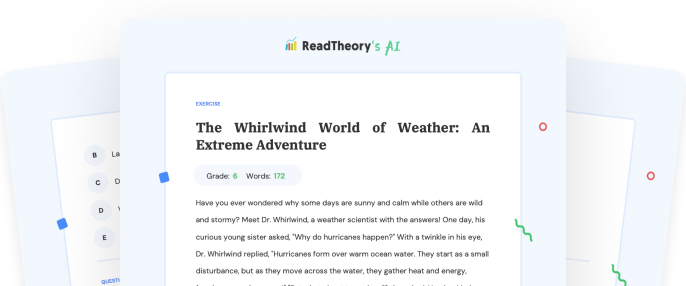Transform Your Teaching
with AI-Powered Worksheets
With ReadTheory’s Instant Worksheet Builder, you can create engaging, grade-appropriate worksheets tailored to your students in minutes. Spark curiosity, save time, and empower critical thinking with AI-powered tools designed for teachers like you.


Project Inalienable: The Rights We All Hold
In Ms. Johnson s sixth-grade class, a special project was assigned - Project Inalienable. The students looked puzzled until Ms. Johnson explained, Inalienable rights are fundamental freedoms that belong to every person and cannot be taken away. The class was intrigued. They split into groups to explore different rights, like freedom of speech, religion, and fairness. Throughout the week, they discovered that these rights are the cornerstones of their daily lives, allowing them the freedom to express themselves and believe what they wish. They realized that these rights were not just words on paper but shields protecting them. By the end of the project, the students not only had a deeper understanding of their inalienable rights but also a greater appreciation for them.
Question 1
What is the name of the project assigned by Ms. Johnson?
Project Inalienable
Project Freedom
Project Rights
Project Shield
Project Speech
Question 2
What are inalienable rights?
Rights that can be given and taken away
Rights that belong to only some people
Rights that belong to every person and cannot be taken away
Rights that are written on paper
Rights that are granted by the government
Question 3
What are some examples of inalienable rights?
Freedom of speech, religion, and fairness
Right to vote, right to bear arms, and right to free education
Right to work, right to property, and right to social security
Right to food, right to water, and right to shelter
Right to travel, right to privacy, and right to internet access
Question 4
What did the students realize during the project?
They realized that the rights were just words on paper
They realized that these rights were not just words on paper but shields protecting them
They realized that the rights didn t matter
They realized that the rights could be taken away
They realized that the rights were granted by the government
Question 5
What did the students learn by the end of the project?
They learned about the government s role in granting rights
They learned that rights can be given and taken away
They learned that the rights did not matter in their daily lives
They had a deeper understanding of their inalienable rights and a greater appreciation for them
They learned that the rights were just words on paper
 or share via
or share via

Assign the ReadTheory pretest to determine students' reading levels.

Why Teachers Love
Instant Worksheet Builder?

Tailored Content for Every Student
Craft worksheets with passages and multiple-choice questions customized to your chosen topic and grade level, ensuring relevance and engagement.

Save Hours
of Prep Time
Our AI, Lexi, generates complete worksheets—passages, questions, and answers—in minutes, freeing you to focus on teaching, not planning.

Standards-Aligned Learning
Every worksheet is designed to boost reading comprehension and critical thinking, aligning seamlessly with State Standards to help your students shine.
Personalized teaching
for personalized learning
Browse worksheets created and refined by educators using Lexi—your source for inspiration and ready-to-use resources.


ReadTheory is free for Teachers to use.
Join thousands of educators using ReadTheory for free. Sign up today and start creating in just minutes!





